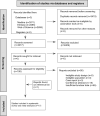Genome-Wide, Non-Invasive Prenatal Testing for rare chromosomal abnormalities: A systematic review and meta-analysis of diagnostic test accuracy
- PMID: 39499701
- PMCID: PMC11537411
- DOI: 10.1371/journal.pone.0308008
Genome-Wide, Non-Invasive Prenatal Testing for rare chromosomal abnormalities: A systematic review and meta-analysis of diagnostic test accuracy
Abstract
Genome-Wide Non-Invasive Prenatal Testing (GW-NIPT) can provide positive results not only for common autosomal aneuploidies but also for rare autosomal trisomies (RATs) and structural chromosomal abnormalities (StrCAs). Due to their rarity, there is currently insufficient information on positive predictive value PPV of RAT and StrCA-positive cases in the literature. In this study, the screening accuracy and pregnancy outcomes of cases positive for rare chromosomal abnormalities were examined based on publications in which GW-NIPT testing was performed. True positive cases were determined using two different methodologies. One was a confirmed methodology, where only cases validated by genetic testing were considered true positives with a definite diagnosis, and the other was an extended methodology, where, in addition to cases confirmed by genetic testing, intrauterine fetal death and termination of pregnancy due to an abnormality confirmed by ultrasound examination were also considered true positives, where no diagnosis had been made but the fetus was probably affected. Seventeen studies were analyzed, with a total GW-NIPT population of 740,076. Of these, 1,738 were RAT positive. Using the confirmed method, we found the highest rates of true positives in T16, followed by T22, and T2, using the extended method, the highest rate of true positives in T15, T16 and T22. This is the first meta-analysis to determine the frequency of rare chromosomal abnormalities, test-positive rates, and the PPV of each chromosomal abnormality with high precision. Our results could aid pre- and post-test genetic counselling and help patients and clinicians in their decision-making.
Copyright: © 2024 Konya et al. This is an open access article distributed under the terms of the Creative Commons Attribution License, which permits unrestricted use, distribution, and reproduction in any medium, provided the original author and source are credited.
Conflict of interest statement
The authors have declared that no competing interests exist.
Figures




References
Publication types
MeSH terms
LinkOut - more resources
Full Text Sources

